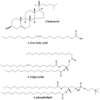Template:Featurt airticle/Mey 2019
In biology, a lipid is a substance o biological oreegin that is soluble in nonpolar solvents. It comprises a group o naiturally occurrin molecules that include fats, wauxes, sterols, fat-soluble vitamins (sic as vitamins A, D, E, an K), monoglycerides, diglycerides, triglycerides, an phospholipids. The main biological functions o lipids include storin energy, seegnalin, an actin as structural components o cell membranes. Lipids hae applications in the cosmetic an fuid industries as weel as in nanotechnology.
Scientists whiles broadly define lipids as hydrophobic or amphiphilic smaw molecules; the amphiphilic naitur o some lipids allous them tae form structurs sic as vesicles, multilamellar/unilamellar liposomes, or membranes in an aqueous environment. Biological lipids originate entirely or in pairt frae twa distinct teeps o biochemical subunits or "biggin-blocks": ketoacyl an isoprene groups. Uisin this approach, lipids mey be dividit intae aicht categories: fatty acids, glycerolipids, glycerophospholipids, sphingolipids, saccharolipids, an polyketides (derived frae condensation o ketoacyl subunits); an sterol lipids an prenol lipids (derived frae condensation o isoprene subunits).
